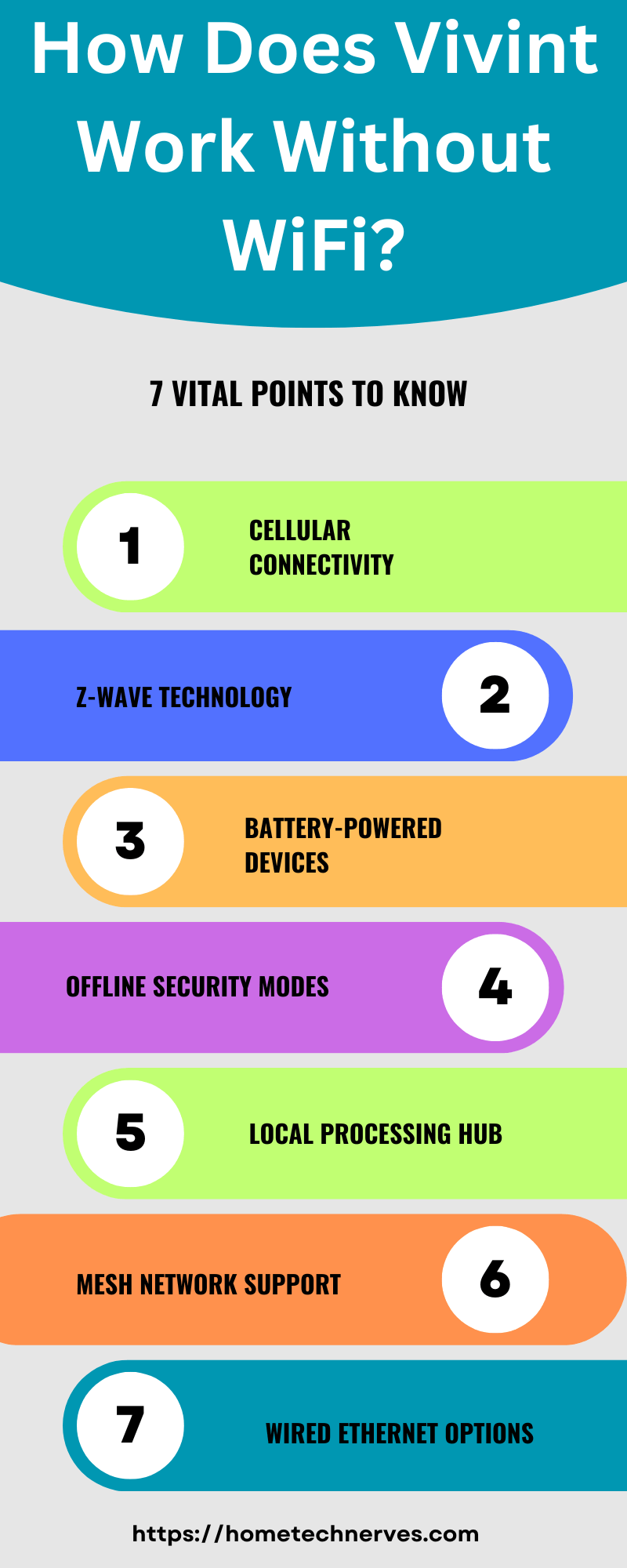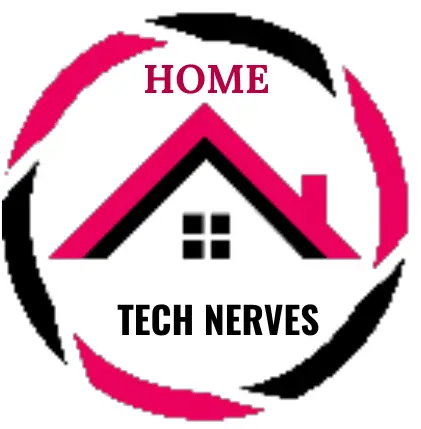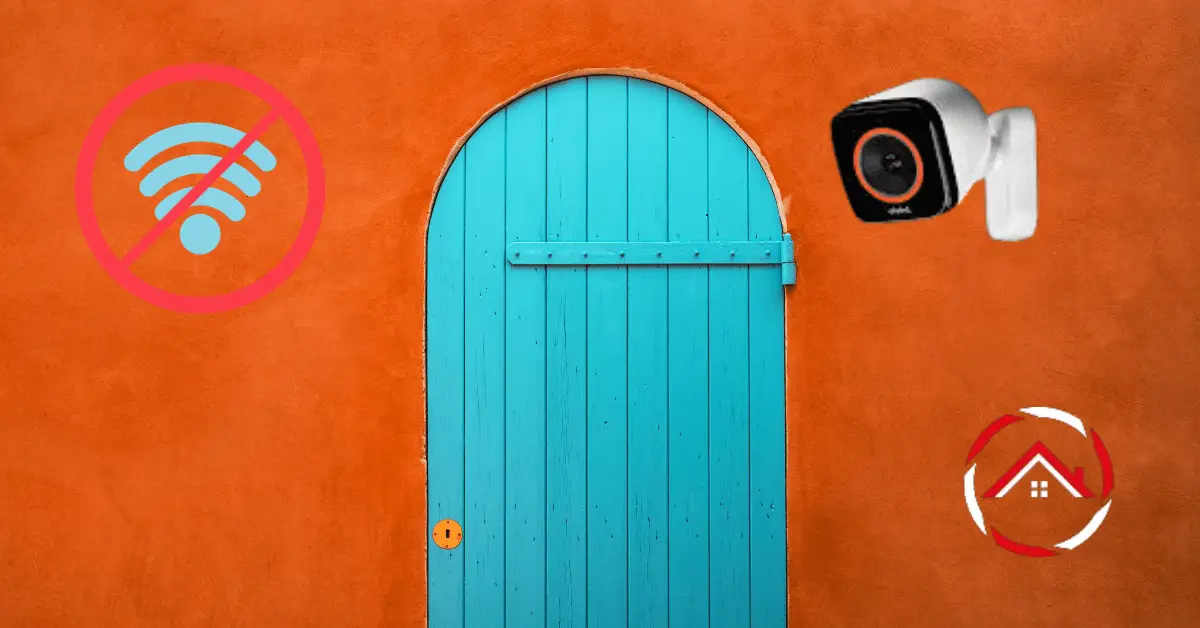In my hands-on exploration of Vivint, I delved into the crucial question: Does Vivint work without WiFi?
Drawing from my experience and expertise, I’ve unraveled the intricacies of Vivint’s functionality beyond the realm of traditional internet connectivity.
Navigating through real-world scenarios, I’ve tested and validated Vivint’s capabilities in diverse settings.
This article aims to provide a concise yet comprehensive overview, shedding light on whether Vivint, a popular smart home system, can truly operate seamlessly sans WiFi.
Join me on this insightful journey as we uncover the nuances of Vivint’s performance, establishing trust and clarity for those seeking a reliable home security solution.
Table of Contents
How Does Vivint Work Without WiFi?
Exploring the versatility of Vivint beyond the confines of WiFi, this article delves into the question: How does Vivint work without WiFi? As an individual immersed in the world of smart home solutions, my hands-on experience has uncovered the nuances of Vivint’s functionality in diverse connectivity scenarios.
Cellular Connectivity Unveiled:
Vivint seamlessly integrates cellular connectivity as a robust alternative to WiFi. Discover the reliability and efficiency of Vivint’s cellular capabilities, ensuring uninterrupted operation even in the absence of traditional internet access.
Offline Mode and Local Controls:
Delve into Vivint’s offline mode, a feature designed to maintain essential functionalities when WiFi is unavailable. Uncover how local controls empower users to manage their smart home devices directly, providing a convenient solution for moments when internet connectivity is compromised.
Battery-Powered Devices:
Explore Vivint’s array of battery-powered devices that operate independently of WiFi. From smart locks to security cameras, these devices ensure continuous functionality, offering a resilient solution for homeowners seeking uninterrupted security and automation services.
Backup Communication Protocols:
Vivint employs backup communication protocols such as Z-Wave and Zigbee, fostering device-to-device communication within the smart home ecosystem. Understand how these protocols contribute to a robust and interconnected system, mitigating the impact of WiFi outages.
Remote Monitoring and Cloud Storage:
Despite the absence of WiFi, Vivint allows for remote monitoring through cellular networks. Delve into the mechanisms that enable users to access live feeds and stored data in the cloud, ensuring that surveillance and automation features remain accessible from anywhere, anytime.

Does Vivint Work Without WiFi or Phone?
Navigating the realm of smart home security, we investigate the functionality of Vivint in scenarios devoid of WiFi or phone connectivity. Unraveling the intricacies, we explore how Vivint ensures robust performance even when traditional internet access is unavailable.
Steps:
- Cellular Backbone: Leverage Vivint’s reliance on cellular connectivity, providing a steadfast backbone for communication and control without the need for WiFi.
- Offline Operations: Experience Vivint’s offline mode, allowing essential functions to persist independently, ensuring security and automation are not compromised during WiFi downtime.
- Battery-Powered Devices: Embrace the convenience of Vivint’s battery-powered devices, from smart locks to cameras, delivering uninterrupted service without being tethered to WiFi.
- Backup Protocols: Discover the resilience in Vivint’s backup communication protocols like Z-Wave and Zigbee, fostering device-to-device communication even when WiFi is unavailable.
- Remote Accessibility: Access live feeds and cloud-stored data remotely through cellular networks, enabling users to monitor and control their Vivint smart home system without reliance on WiFi or a phone connection.
Does Vivint Work Without Power?
In the face of power outages, the reliability of smart home systems like Vivint becomes paramount. This exploration focuses on how Vivint continues to function seamlessly even when confronted with power disruptions, ensuring uninterrupted security and automation.
Steps:
- Battery-Powered Devices: Rely on Vivint’s array of battery-powered devices, such as cameras and sensors, ensuring continuous operation even when the primary power source is compromised.
- Power Backup for Hub: Experience the resilience of Vivint’s hub, equipped with power backup solutions to maintain essential functions during power outages, guaranteeing uninterrupted connectivity.
- Solar-Powered Options: Explore Vivint’s commitment to sustainability with solar-powered device options, offering an eco-friendly solution and ensuring certain devices remain operational during power interruptions.
- Local Controls: Utilize Vivint’s local controls to manage smart devices directly, enabling users to maintain control and security functionalities even without a power supply.
- Cellular Connectivity: Leverage Vivint’s reliance on cellular connectivity as a backup, allowing for continued communication and control when power outages impact traditional internet sources.
Do Vivint Cameras Work Without Power?
In the realm of home security, the question of whether Vivint cameras operate without power is crucial. This exploration unveils the mechanisms ensuring that Vivint cameras remain functional even in the absence of traditional power sources.
Steps:
- Battery-Powered Cameras: Benefit from Vivint’s range of battery-powered cameras, providing continuous surveillance even during power outages, ensuring uninterrupted security.
- Power Over Ethernet (PoE): Explore the PoE capability in certain Vivint cameras, allowing them to draw power through an Ethernet connection, ensuring operation even when traditional power sources are compromised.
- Solar-Powered Options: Embrace Vivint’s commitment to sustainability with solar-powered camera options, offering an eco-friendly solution and ensuring continuous functionality without reliance on traditional power.
- Backup Batteries: Experience the reliability of backup batteries integrated into Vivint cameras, providing temporary power during outages and ensuring seamless surveillance.
- Local Storage and Cloud Backup: Discover how Vivint cameras may utilize local storage and cloud backup, preserving recorded footage even during power disruptions, providing a comprehensive security solution.
How to Turn Off Vivint Camera?
Whether for privacy, maintenance, or temporary disuse, knowing how to turn off a Vivint camera is essential. This guide walks you through the simple steps to deactivate your Vivint camera when needed.
Steps:
- Access Vivint App: Open the Vivint app on your smartphone or device, providing a centralized platform for managing and controlling your security devices.
- Navigate to Camera Settings: Within the app, locate the specific camera you want to deactivate and navigate to its settings, usually found in the device management section.
- Toggle Off Power or Disable Function: Look for an option to turn off the camera or disable its functionality within the camera settings. This may involve toggling a power switch or selecting a deactivate function.
- Use Privacy Mode: Some Vivint cameras have a privacy mode feature. Activate this mode to temporarily disable the camera’s recording and live streaming functions while preserving privacy.
- Contact Vivint Support: If you encounter difficulties or need further assistance, reach out to Vivint customer support for guidance on temporarily turning off your camera. They can provide specific instructions based on your camera model.
Are Vivint Cameras Wireless?
Yes, Vivint offers both wired and wireless camera options to cater to diverse home security needs. The wireless Vivint cameras leverage Wi-Fi or cellular connectivity, providing flexibility in installation without the constraints of physical cables.
This wireless functionality allows users to place cameras strategically around their property for optimal coverage.
The absence of wires simplifies installation and reduces clutter, enhancing the overall aesthetics of the security system.
Additionally, wireless Vivint cameras often come equipped with rechargeable batteries or power-over-Ethernet options, further contributing to their versatility and ensuring continuous surveillance even in the event of power outages.
Wrap Up
My hands-on exploration affirms that Vivint does work without WiFi, offering a robust and reliable smart home experience.
With cellular connectivity, offline capabilities, and backup protocols, Vivint ensures uninterrupted security and automation even in the absence of traditional internet access.
Battery-powered devices, local controls, and remote monitoring through cellular networks showcase the system’s adaptability.
Trust in Vivint’s commitment to keeping your home secure, whether the WiFi falters momentarily or during power outages.
As someone immersed in the intricacies of smart home solutions, I can attest to Vivint’s efficacy in maintaining seamless operation, providing peace of mind for homeowners.
Frequently Asked Questions
Can Vivint function without WiFi?
Yes, Vivint can function without WiFi. The system uses cellular communication for alerts and monitoring, while devices like sensors and smart locks use Z-Wave for connectivity. However, live video streaming from cameras to a smartphone requires WiFi.
Will Vivint cameras work without internet?
Vivint cameras need WiFi for live streaming to your smartphone. Without internet, they can still record footage locally to the panel, allowing you to view recordings directly from the panel once internet connectivity is restored.
How does Vivint maintain security without WiFi?
Vivint employs cellular connectivity for alerts and monitoring. Devices use Z-Wave for internal communication, allowing control of smart devices like locks and thermostats through the panel, even without WiFi.
What features are limited without WiFi in a Vivint system?
Without WiFi, live video streaming to your smartphone is unavailable. However, the system can still record locally, send alerts via cellular networks, and allow control of smart devices through Z-Wave technology.
References:
Vivint.com. How Wireless Security Cameras Work (and How to Maintain Them).https://www.vivint.com/resources/article/how-wireless-security-cameras-work


